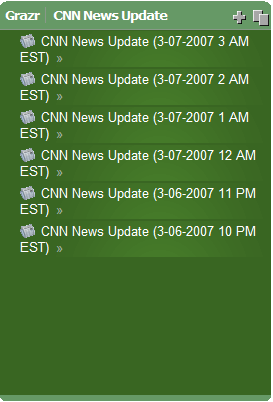What?

A "feedmap" is an outline that provides a central place to find, subscribe to, and see how feeds are organized — much like a traditional web sitemap. A feedmap takes the idea further by making it possible to preview and actually interact with feed content.
We didn't realize we needed sitemaps until the web became popular and websites became complex. Although feeds aren't quite mainstream yet, many sites already publish more than one. As this trend continues, people will want a central place to find feeds. Some sites already recognize this, and publish a list of feeds. A feedmap expands on this by showing how feeds are organized, and letting people preview and interact with the content. Since it's written in OPML, a feedmap;
-
allows publishers to organize feeds in a meaningful structure
-
makes it easy for people to preview feeds
-
can be imported into most feed readers
-
makes it easy to subscribe to individual feeds
-
may enable people to subscribe to entire feedmaps in the future
An example feedmap
Here's a feedmap for my blog, (if you're reading this in a feed reader, you'll have to use the link) displayed in Grazr:
Update: 2007.01.15 - There have been some intermittent problems displaying my blog's feedmap in Grazr. I'm working with the Grazr team to try to figure out what's going on, and plan to contact Yahoo! Webhosting support as well. Sorry for the inconvenience! Since the problem is intermittent, it's possible you might be able to see the feedmap in the Grazr panel on my blog's sidebar; it's also listed there, and sometimes that loads even though this example doesn't.
Update: 2007.03.31 - Yahoo's tech support has been quite unhelpful in resolving the problem I mention above, so I'm hosting my feedmap at Grazr.com's new hosting service, which wasn't available when I created this post. Ultimately, that's where I want to store my outines. Unfortunately, this allows the outline to display quickly, but doesn't solve the problem of actually displaying the feed content within Grazr, since there's something blocking a couple of grazr.com's servers from accessing my Yahoo-hosted site. I'm really disappointed that I wasn't able to get better support from Yahoo. I haven't given up, but they seem to have decided to ignore my most recent response in our correspondence.
Audience
Anyone who publishes more than one feed should consider publishing a feedmap.
Why?
A feedmap organizes feeds in one place using a standard format, and lets people preview feed content without being forced to subscribe.
The newest versions of popular web browsers are just beginning to get better at helping people subscribe to feeds, but they're still not very good at it, and subscribing won't always be the goal. Once feeds become mainstream, people will see them as another source of potential information overload and become more selective about subscribing. As James Corbett predicted, we'll want to graze feeds more and subscribe less.
There's a new generation of embeddable, "widgetized", web-based feed browsers that are purpose-built for grazing feeds and interacting with feed content — Grazr, Optimal, and Bitty Browser are examples. Grazr is my favorite; it lets you see pictures, listen to audio, and watch video, right in the feed. You don't have to worry about subscribing, but it's easy to do by right clicking on the feed, copying the link, and pasting it into a feed reader.
How?
Build it in OPML, display it in Grazr
This post isn't a tutorial, it's a recommendation for feed publishers to start publishing feedmaps. The details are an exercise for the reader, but it's not hard to create a feedmap:
-
Use OPML to build your feedmap. OPML is an outlining language you use to define the structure of your feedmap. Among its other uses, OPML has become the de facto standard for import and export of feed reader subscription lists. If you're familiar with HTML, OPML is easy to pick up, and the Grazr team has developed really good OPML primer that will get you started.
-
OPML isn't an "official" standard, but until or unless one emerges, having your feedmap in a well-known format that's as widely used as OPML will increase the likelihood that it's easy to convert.
-
Use Grazr to display your feedmap. Grazr is the key to bringing a feedmap to life, since it makes feeds immediately usable. You don't have to use Grazr to display your feedmap — you could just link to the raw OPML file — but that's like linking to the source code of a web page. To make it easy for people to check out your feeds, display it in a feed browser.
Tips & Tricks
-
Make your feedmap modular. If your site publishes various feeds in different topic areas, consider creating separate OPML files for each area and including them in the feedmap. This way you can use them in other outlines, and people can access the specific one they want. (Determining the appropriate level of granularity for doing this will undoubtedly become an art.)













